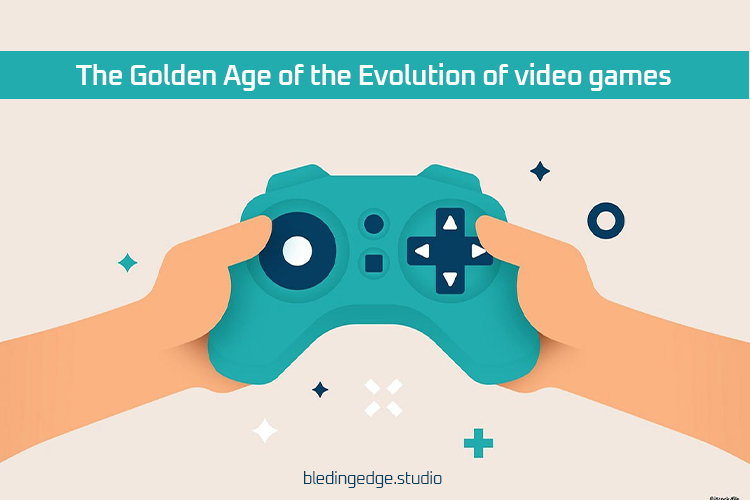Mapping the Evolution of Video Games: From Pong to Virtual Reality in 2023
The Evolution of Video games has come a long way since their humble beginnings. In the past few decades, they have evolved from simple, two-dimensional games with minimal graphics and gameplay too complex, three-dimensional worlds that players can explore and interact with in incredible detail. Today, video games are one of the most popular forms of entertainment in the world, enjoyed by millions of people of all ages and backgrounds. In this article, we will inspect the evolution of video games and how they have evolved over the years, from the very first game of Pong to the latest innovations in virtual reality.
Pong and the Evolution of video games
The evolution of video games can be traced back to the early 1950s when computer scientists began experimenting with simple games and simulations on early computers. However, it was in the late 1960s and early 1970s that the first commercially successful video games were released.
In 1972, Atari released Pong, a simple two-dimensional game that simulated table tennis. The game was a huge success and helped to launch the video game industry. Pong was followed by several other simple games, such as Space Invaders and Pac-Man, which became instant classics and established video games as popular entertainment in the Evolution of video games.
The Golden Age of the Evolution of video games

The late 1970s and early 1980s are called the “golden age” of video games. During this period, the video game industry experienced rapid growth and innovation, with new games and technologies being developed astonishingly.
One of the most significant innovations of this era was the introduction of the arcade game. Arcade games were housed in public places such as arcades, restaurants, and bars and designed to be played by anyone with a few spare coins. Games such as Donkey Kong, Galaga, and Defender became iconic symbols of the era and helped to establish the popularity of video games among a wider audience.
At the same time, home gaming consoles such as the Atari 2600 and the Intellivision were becoming increasingly popular. These consoles allowed players to enjoy arcade-style games from the comfort of their homes and helped further fuel the video game industry’s growth.
The Rise of 3D Graphics in the Evolution of video games
The 1990s saw the introduction of 3D graphics in video games, opening up a new world of possibilities for game developers. With 3D graphics, game designers could create complex, immersive worlds that players could explore in incredible detail.
One of the foremost games to use 3D graphics was Wolfenstein 3D, a first-person shooter game released in 1992. The game was a huge success and helped establish the popularity of the first-person shooter genre, which remains popular today.
Another landmark game of this era was Doom, released in 1993. Doom was a first-person shooter game that used 3D graphics and a new game engine that allowed for more realistic gameplay. The game was a huge success and helped to establish the first-person shooter as one of the most popular genres in video gaming.
The Modern Era of Evolution of Video Games
In the past decade, video games have continued to evolve and innovate rapidly. One of the most significant developments of this era has been the rise of mobile gaming. Mobile games are played on smartphones and tablets and are often designed to be played in short bursts. Mobile games such as Candy Crush and Angry Birds have become the most popular, with millions of players worldwide.
Another major development of the modern video game era is the rise of online gaming. Online gaming allows players to connect with others worldwide and play games together in real time.
Online gaming has become increasingly popular in recent years, thanks partly to the widespread availability of high-speed internet connections. Multiplayer games such as World of Warcraft, League of Legends, and Fortnite have become global phenomena, attracting millions of players and spectators worldwide.
In addition to online gaming, the past decade has also seen the rise of virtual reality (VR) gaming. VR games use advanced technology to create immersive, 360-degree environments that players can explore and interact with in real time. With the help of VR headsets such as the Oculus Rift and the HTC Vive, players can experience games in a whole new way, with the sense of immersion and presence that was once the stuff of science fiction.
The Future of Video Games

So, what is the future of the Evolution of video games? So, what is the future of the Evolution of video games? It’s hard to say for sure, but one thing is certain: the industry will continue to evolve and innovate rapidly. Here are some of the tendencies and developments that we can expect to see in the coming years:
Increased use of artificial intelligence (AI) in gaming: AI is already used in some games to create more intelligent, realistic, non-player characters (NPCs). In the future, we expect to see more games that use AI to create more dynamic and adaptive gameplay.
The continued rise of mobile gaming: Mobile gaming is already hugely popular, and we expect to see even more games designed specifically for smartphones and tablets.
The convergence of gaming and other forms of entertainment: As technology advances, we can expect to see more games that blur the lines between gaming and other forms of entertainment, such as movies, TV shows, and music.
The continued rise of VR gaming: VR gaming is still in its infancy, but we can expect to see more games that take advantage of this technology in the coming years.
The continued growth of esports: Esports (competitive video gaming) is already a multi-billion dollar industry, and we can expect to see even more growth in the coming years as more players and sponsors get involved.
While the video game industry has come a long way in terms of technology and popularity, it has faced its fair share of controversies and criticisms. One of the main criticisms against video games is their potential negative impact on players, particularly in terms of violence and addiction.
Some studies have demonstrated that playing violent video games can increase aggression in players, while others have found no link between video games and violent behavior. Similarly, there have been concerns about the addictive nature of video games, with some players reportedly spending hours or even days playing without taking breaks or attending to other responsibilities.
These issues have led to calls for greater regulation of the video game industry, particularly regarding content and age restrictions. In many countries, video games are subject to rating systems similar to those used for movies, with age ratings indicating the appropriate age group for each game.
Despite these controversies, the video game industry continues to grow and evolve. In a few years, there has been a rapidly growing focus on diversity and inclusion in video games, with efforts to create more diverse and representative characters and storylines. There has also been a growing recognition of the potential of video games for education and training purposes, with some schools and businesses incorporating games into their curriculum and training programs.
The Evolution of video games from Pong to virtual reality has been a remarkable journey, marked by rapid advances in technology and innovation. From simple, pixelated graphics to fully immersive 3D worlds, video games have become one of the world’s most popular and influential forms of entertainment.
While the Evolution of video games has faced its fair share of criticisms and controversies, there is no doubt that they will continue to play a main role in shaping the future of entertainment, education, and technology. Whether you’re a casual player or a die-hard gamer, there has never been a better time to join the video game community.
Pong:
Pong is widely considered the first commercially successful video game and played a crucial role in the industry’s early days. The game was designed by Nolan Bushnell and Ted Dabney, who founded Atari’s video game company in 1972.
Pong was based on the classic game of table tennis, with players using paddles to hit a virtual ball back and forth across a screen. The game was displayed on a black and white television and used simple, blocky graphics to depict the paddles, ball, and playing field.
The Evolution of video games was an instant hit, with players lining up to play the simple but addictive game. Pong was soon followed by a string of other successful video games, including Space Invaders, Pac-Man, and Donkey Kong, and the video game industry took off, with arcades popping up worldwide.
Despite its simple graphics and gameplay, Pong remains an important milestone in the evolution of video games. The game helped to establish video games as a viable and profitable industry and paved the way for the development of more complex and sophisticated games in the years to come.
Today, Pong is still fondly remembered by many gamers as a classic and iconic game that helped to shape the video game industry as we know it today. While it may not have the flashy graphics or advanced technology of modern video games, Pong’s simple and timeless gameplay has stood the test of time and remains a beloved part of video game history.
Concept of virtual reality (VR):
The concept of virtual reality (VR) can be traced back to the mid-20th century, with early experiments in computer graphics and computer-generated imagery (CGI). However, it was in the 1980s and 1990s that the first true VR systems emerged.
One of the first VR systems was the VPL Research DataGlove, developed by Jaron Lanier and Thomas Zimmerman in the mid-1980s. The DataGlove used sensors to track the movements of a user’s hand and fingers, allowing them to interact with virtual objects in real time.
Another early VR system was the Virtual Environment Workstation (VIEW), developed by NASA in the late 1980s. VIEW used a head-mounted display (HMD) to immerse users in virtual environments, allowing them to explore and interact with simulated environments and objects.
In the early 1990s, several consumer VR systems were released, including the Virtual Boy by Nintendo and the iGlasses by Virtual I/O. However, these early systems were plagued by technical issues and limited capabilities, failing to gain widespread consumer acceptance.
It was in the mid-2010s that VR technology began to see a resurgence, thanks partly to advances in computing power, graphics processing, and motion tracking technology. In 2012, the Oculus Rift VR headset was introduced via a Kickstarter campaign, and it quickly became a sensation, attracting millions of dollars in funding and sparking a wave of interest in VR technology.
Since then, numerous other VR headsets have been released, including the HTC Vive, the PlayStation VR, and the Samsung Gear VR. These systems use a combination of high-resolution displays, motion sensors, and tracking technology to create highly immersive and realistic virtual environments.
VR technology is used in various applications, including gaming, education, training, and therapy. From fully immersive video games and training simulations to virtual tours of real-world locations and museums, VR technology has opened up a new world of possibilities for users to explore and experience. While VR technology is still in its early stages, and there are certainly still technical and practical challenges to overcome, it is clear that the potential of virtual reality is enormous and will continue to play an increasingly important role in our lives for years to come.
The Evolution of video games from Pong to virtual reality (VR) gaming has been long and fascinating. In just a few decades, the video game industry has undergone a rapid transformation, with advances in technology and innovation leading to a whole new world of gaming experiences. Let’s take a closer look at the major milestones in this journey.
The 1970s-1980s: The Birth of Gaming and Evolution of video games
The Evolution of the video games industry began with the creation of Pong, which was released in 1972. Pong was the first successful commercial video game and helped establish the industry as a viable and profitable market. Over the next few years, many more arcade games were created, including Space Invaders, Pac-Man, and Donkey Kong. These games were simple, using basic graphics and sound, but they were hugely popular and set the stage for what was to come.
The 1980s-1990s: The Rise of Home Gaming and Evolution of video games
The Evolution of the video games industry began to shift in the 1980s and 1990s as home gaming systems became more popular. The Atari 2600 was declared in 1977 and helped to establish home gaming as a viable market. Other home gaming systems, such as the Nintendo Entertainment System and the Sega Genesis, were released in the following years and quickly became popular. These systems were more advanced than arcade games, offering better graphics, sound, and gameplay. As home gaming became more popular, the video game industry began to evolve rapidly, with new games and consoles being released regularly.
1990s-2000s: The Emergence of 3D Graphics and Evolution of video games
In the 1990s, 3D graphics emerged, adding a new level of depth and realism to the Evolution of video games. Games like Doom, Quake, and Half-Life were some of the first to use 3D graphics, and they quickly became hugely popular. The release of the Sony PlayStation in 1994 helped to cement 3D graphics as a major part of the video game industry, and it wasn’t long before other consoles and games followed suit.
The 2000s-2010s: The Advent of Online Gaming and Evolution of video games

The rise of the internet and high-speed broadband connections in the 2000s led to the advent of online gaming. Games like Everquest, World of Warcraft, and Call of Duty were some of the first to offer online multiplayer capabilities, allowing players to connect and compete with others worldwide. This era also saw the release of popular gaming platforms like Steam and Xbox Live, which allowed players to download and play games directly on their computers and consoles.
2010s-Present: The Era of Virtual Reality and Evolution of video games
The last decade has seen the start of virtual reality (VR) as a major player in the Evolution of the video games industry. VR headsets like the Oculus Rift, HTC Vive, and PlayStation VR have enabled players to immerse themselves in fully-realized 3D worlds, offering unprecedented immersion and interactivity. VR has also opened up new possibilities for gaming, such as using hand and body movements to control games and interact with virtual objects.
The journey from Pong to VR has been a long and fascinating one, with each era of gaming building upon the innovations and advancements of the previous one. It’s impossible to foresee what the future holds for the video game industry, but new technologies and innovations will continue to shape the way we play and experience games for years to come.
Conclusion
The Evolution of video games has come a long way since the days of Pong. The industry has evolved and innovated rapidly from simple 2D games to complex, immersive 3D worlds and virtual reality. Today, video games are one of the most popular forms of entertainment in the world, enjoyed by millions of people of all ages and backgrounds.
As we look to the future, it’s evident that the video game industry will continue to evolve and innovate, with new technologies and trends always emerging. Whether you’re a usual player or a hardcore gamer, there has never been a better time to be a fan of video games.

